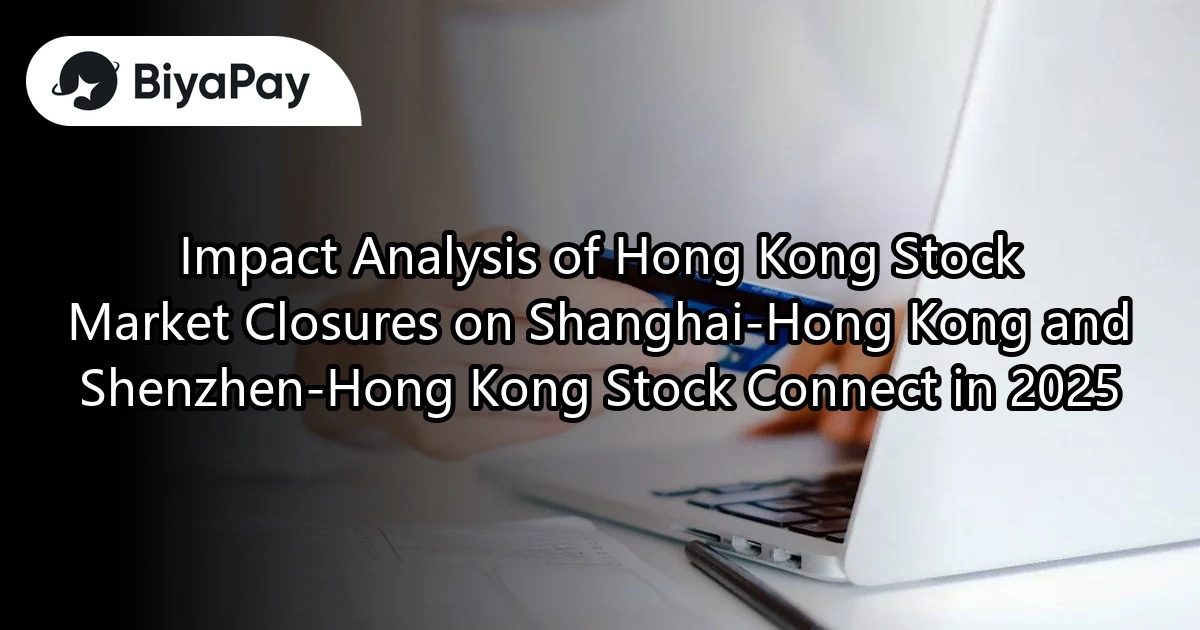- EasyCard
- Trade
- Help
- Announcement
- Academy
- SWIFT Code
- Iban Number
- Referral
- Customer Service
- Blog
- Creator
Impact Analysis of Hong Kong Stock Market Closures on Shanghai-Hong Kong and Shenzhen-Hong Kong Stock Connect in 2025

Image Source: unsplash
The 2025 Hong Kong stock market closure schedule will directly impact the northbound and southbound trading arrangements of Shanghai-Hong Kong and Shenzhen-Hong Kong Stock Connect. For you, the 2025 Hong Kong stock market closures mean you need to reassess your trading plans, especially due to potential liquidity declines during closure periods. Closure dates such as January 1, March 29, July 1, and October 1 may lead to a suspension of market trading activities, making it difficult for investors to execute immediate trades. Half-day closures, such as December 31, may also limit your trading flexibility, especially when you rely on Shanghai-Hong Kong or Shenzhen-Hong Kong Stock Connect for cross-border investments.
In fact, the 2025 Hong Kong stock market closures not only affect trading hours but may also alter market liquidity metrics. You need to closely monitor these changes and adjust your investment strategies in advance to address potential impacts.
Key Points
- Understand the 2025 Hong Kong stock market closure dates in advance and adjust your trading plans to avoid liquidity issues caused by closures.
- During full-day closures, southbound trading is completely suspended, requiring a reassessment of investment strategies relying on southbound trading.
- During half-day closures, trading hours are shortened, requiring you to complete trades within a limited timeframe, increasing operational pressure.
- During closure periods, declining liquidity may lead to increased price volatility, necessitating close attention to market dynamics.
- Use closure periods for market analysis, review your investment portfolio, enhance your investment capabilities, and prepare for future opportunities.
2025 Hong Kong Stock Market Closure Schedule and Arrangements
2025 Full-Day and Half-Day Closure Dates
The 2025 Hong Kong stock market closure schedule is crucial for your investment plans. Below are some important closure dates and their types:
| Date | Closure Type | Remarks |
|---|---|---|
| January 28, 2025 | Half-Day Closure | Closed in the afternoon |
| January 29, 2025 | Full-Day Closure | Lunar New Year holiday, closed until January 31 |
| February 3, 2025 | Trading Resumption | Hong Kong stock market resumes trading on this day |
You need to pay special attention to the closure arrangements during the Lunar New Year. From January 29 to January 31, the Hong Kong stock market will be completely closed. This period may affect your fund liquidity and trading plans. Half-day closures, such as January 28, mean the market is only open for trading in the morning. Understanding these dates in advance helps you better plan your investment strategies.
Shanghai-Hong Kong and Shenzhen-Hong Kong Stock Connect Northbound and Southbound Trading Arrangements
The 2025 Hong Kong stock market closure schedule directly affects the northbound and southbound trading of Shanghai-Hong Kong and Shenzhen-Hong Kong Stock Connect. When the Hong Kong stock market is fully closed, southbound trading is completely suspended. This means you cannot buy or sell Hong Kong stocks through Shanghai-Hong Kong or Shenzhen-Hong Kong Stock Connect.
Northbound trading is unaffected by Hong Kong stock market closures, as the mainland Chinese stock markets continue to operate normally. You can use this time to focus on northbound trading and explore investment opportunities in the mainland market. During half-day closures, southbound trading is limited to the morning session. You need to complete trades within this limited timeframe, which may increase operational pressure.
Trading Restrictions and Considerations During Closures
During Hong Kong stock market closures, you need to understand the trading restrictions and considerations. On full-day closures, all Hong Kong stock-related trading activities, including stock trading and fund settlement, are suspended. This may result in your funds being unable to flow immediately.
During half-day closures, trading is limited to the morning session. You need to plan your trading in advance to avoid missing important investment opportunities due to time constraints. Additionally, market liquidity is typically lower during closure periods, which may lead to increased price volatility. You should closely monitor market dynamics and adopt appropriate risk management measures.
Tip: The 2025 Hong Kong stock market closure schedule may affect your investment flexibility. Understanding closure dates and related restrictions in advance helps you better respond to market changes.
Impact of Hong Kong Stock Market Closures on Shanghai-Hong Kong and Shenzhen-Hong Kong Stock Connect

Image Source: pexels
Analysis of Impact on Southbound Trading
The 2025 Hong Kong stock market closure schedule has a significant impact on southbound trading. When the Hong Kong stock market is fully closed, you cannot buy or sell Hong Kong stocks through Shanghai-Hong Kong or Shenzhen-Hong Kong Stock Connect. This means you may need to adjust your investment plans, especially if you rely on southbound trading for short-term gains.
During half-day closures, southbound trading is limited to the morning session. This shortened trading time may increase your operational pressure, particularly in volatile market conditions. You need to prepare in advance and develop clear trading strategies to complete trades within the limited timeframe.
Additionally, market liquidity is typically lower during closure periods. Declining liquidity may lead to wider bid-ask spreads, increasing trading costs. You should closely monitor market dynamics and choose appropriate trading timings to minimize potential losses.
Analysis of Impact on Northbound Trading
The 2025 Hong Kong stock market closure schedule has a relatively minor impact on northbound trading. Since the mainland Chinese stock markets operate normally during Hong Kong closures, you can use this time to focus on northbound trading. This provides a good opportunity to explore investment opportunities in the mainland market.
However, northbound trading liquidity may be indirectly affected by Hong Kong stock market closures. Some investors may choose to temporarily exit the market, leading to a decline in trading volume. You need to be aware of this situation and adjust your investment strategies based on actual market performance.
Before major economic data releases, market volatility is typically low. You can use this time for in-depth market analysis to identify potential investment opportunities. OANDA’s economic calendar provides daily economic data release times, which are crucial for your trading decisions.
Potential Impact of Closures on Market Liquidity and Volatility
The 2025 Hong Kong stock market closure schedule may have a profound impact on market liquidity and volatility. Declining liquidity is a primary reason, often leading to increased market volatility, especially during the morning hours in Tokyo time. During this period, liquidity is lower, price fluctuations are smaller, but bid-ask spreads may widen, increasing trading costs.
Market volatility may spike sharply after major economic data releases. You need to closely monitor the release times of these data and adjust your trading strategies based on market reactions. Understanding liquidity trends during closure periods in advance helps you better respond to market changes.
Additionally, market dynamics during closure periods may be influenced by other global markets. You can use this time to analyze the performance of other markets and seek cross-market investment opportunities. This not only helps diversify risks but also enhances your investment returns.
Tip: Market volatility during closure periods may present challenges but also offers opportunities for in-depth market analysis. You should use this time to develop more comprehensive investment strategies to address future market changes.
Strategies for Investors to Address Hong Kong Stock Market Closures
Adjusting Investment Plans in Advance
During Hong Kong stock market closures, you need to plan your investment strategies in advance to avoid disruptions to fund flows due to trading suspensions. First, check the closure dates and adjust your trading schedule accordingly. Ensure important trades, especially those involving large amounts, are completed before closures.
Second, analyze your investment portfolio. During closure periods, market liquidity may decline, and price volatility for some stocks may increase. You can reduce holdings in high-risk stocks and shift to more stable investment options, such as fixed deposits at Hong Kong banks or USD-denominated bonds. This can reduce risks during closures.
Finally, set clear goals. Planning in advance helps you stay calm during closures and avoid impulsive decisions due to market volatility.
Exploring Investment Opportunities in Other Markets
When the Hong Kong stock market is closed, you can turn your attention to other markets, such as the Chinese or U.S. stock markets. These markets continue to operate normally during Hong Kong closures, providing you with more investment options.
Northbound trading in the Chinese stock market is a direction worth exploring. You can use Shanghai-Hong Kong or Shenzhen-Hong Kong Stock Connect to trade and seek stocks with growth potential. The U.S. stock market offers diverse investment opportunities, such as technology or energy stocks. These stocks are often closely tied to the global economy, providing options to diversify risks.
Additionally, the forex market is another area worth exploring. During Hong Kong stock market closures, the USD/HKD exchange rate may fluctuate. You can capitalize on these fluctuations for forex trading to increase profits.
Risk Management Recommendations During Closures
Risk management is crucial during closure periods. First, maintain fund liquidity. Avoid investing all funds in high-risk assets and ensure sufficient cash reserves to handle unexpected situations.
Second, closely monitor market dynamics. Although the Hong Kong stock market is closed, changes in other global markets may indirectly affect your investments. You can use market analysis tools, such as Bloomberg or Yahoo Finance, to track the latest market trends.
Finally, develop contingency plans. Unexpected market volatility, such as sharp exchange rate changes or sudden events in other markets, may occur during closures. Preparing contingency measures in advance, such as setting stop-loss points or diversifying investments, can help minimize losses.
Tip: The closure period is a good time to review your investment strategies. You can use this time for in-depth analysis to prepare for future investments.
Market Risks and Opportunities During Closures

Image Source: pexels
Potential Market Volatility During Closures
During Hong Kong stock market closures, market volatility may increase. Declining liquidity is one of the main reasons. When market participants decrease, bid-ask spreads may widen, leading to higher trading costs. You need to pay special attention to price changes before and after closures, as the market may experience short-term price jumps.
Additionally, global market dynamics may indirectly affect Hong Kong stock-related investment targets. For example, major events in the U.S. stock market or policy changes in the Chinese stock market may trigger fluctuations in market sentiment. You should closely monitor these external factors and adjust your investment strategies based on market reactions.
Tip: Volatility during closure periods may present challenges but also offer short-term trading opportunities. You can use technical analysis tools, such as moving averages or relative strength index, to assess market trends.
How to Conduct Market Analysis During Closures
The closure period is an ideal time for in-depth market analysis. You can use this time to review your investment portfolio and evaluate the performance of various assets. Below are some effective analysis methods:
- Fundamental Analysis: Review company financial statements and industry trends to assess long-term growth potential.
- Technical Analysis: Use charting tools, such as candlestick charts or Bollinger Bands, to evaluate short-term stock trends.
- Macroeconomic Analysis: Monitor global economic indicators, such as U.S. non-farm payroll data or China’s manufacturing PMI, which may influence market sentiment.
You can also use the closure period to learn new investment techniques or attend financial courses to enhance your investment capabilities. This will help you better seize investment opportunities when the market reopens.
Strategies for Long-Term Investors
If you are a long-term investor, the closure period is a good time to review your investment goals. You can assess whether your asset allocation aligns with your risk tolerance and financial objectives. Below are some recommendations:
- Diversify Investments: Allocate funds to different markets and asset classes, such as USD fixed deposits at Hong Kong banks or U.S. technology stocks, to reduce the impact of single-market volatility.
- Set Stop-Loss Points: Establish reasonable stop-loss points for each investment to avoid significant losses due to market volatility.
- Focus on Long-Term Trends: Analyze the long-term growth potential of industries, such as new energy or artificial intelligence, which may offer stable returns.
Tip: Long-term investors should remain patient and avoid changing strategies due to short-term volatility. The closure period is a good opportunity to review investment plans and better achieve financial goals.
The 2025 Hong Kong stock market closure schedule will directly impact the trading arrangements of Shanghai-Hong Kong and Shenzhen-Hong Kong Stock Connect. You need to plan your investment strategies in advance to avoid disruptions to fund flows and trading plans due to closures. Flexibly responding to market changes can help you maintain stable investment performance during closure periods.
Tip: The closure period is a great time for in-depth market research. You can analyze global market dynamics, seek new investment opportunities, and enhance your investment capabilities. This will help you better capitalize on potential returns when the market reopens.
FAQ
Can I Trade Hong Kong Stocks During Closures?
During Hong Kong stock market closures, you cannot trade Hong Kong stocks. Southbound trading via Shanghai-Hong Kong and Shenzhen-Hong Kong Stock Connect is also suspended. Northbound trading operates normally, allowing you to focus on investment opportunities in the Chinese stock market.
How Do Trading Hours Change During Half-Day Closures?
During half-day closures, trading is limited to the morning session, typically ending at 12:00 PM or 12:30 PM. You need to plan your trading in advance to avoid missing important investment opportunities due to time constraints.
How to Manage Fund Liquidity During Closures?
During closures, you should maintain fund liquidity. Avoid investing all funds in high-risk assets and ensure sufficient cash reserves to handle unexpected situations. USD fixed deposits at Hong Kong banks are a stable option.
Do Hong Kong Stock Market Closures Affect the Forex Market?
Hong Kong stock market closures may indirectly affect the forex market. The USD/HKD exchange rate may fluctuate. You can capitalize on these fluctuations for forex trading to seek short-term profit opportunities.
How Can Investors Conduct Market Analysis During Closures?
During closures, you can review your investment portfolio and evaluate asset performance. Use fundamental analysis, technical analysis, and macroeconomic analysis to gain deep insights into market trends. This period is also a good opportunity to learn new investment techniques.
The 2025 Hong Kong stock market holidays pose challenges for investors in Shanghai-Hong Kong and Shenzhen-Hong Kong Stock Connect, but flexible fund management and low-cost tools can help you navigate with ease. BiyaPay offers a seamless financial solution, enabling trading in U.S. and Hong Kong stocks without offshore accounts, allowing you to participate in the market cost-effectively, whether seizing opportunities in the short trading windows of half-day holidays or pursuing long-term investments to counter liquidity declines during closures.
It supports USD, HKD, and 30+ fiat and digital currencies with real-time exchange rate transparency, helping you manage currency fluctuations and widened spreads during holidays while ensuring fund efficiency. With remittance fees as low as 0.5% across 190+ countries, it facilitates flexible cross-border fund allocation to meet the settlement needs of Northbound and Southbound trading. A flexible 5.48% annualized yield savings product with no lock-in period allows idle funds to grow during market closures, reducing liquidity risks. Sign up for BiyaPay today to combine Hong Kong holiday schedules with BiyaPay’s low-cost tools for a flexible, stable cross-border investment journey!
*This article is provided for general information purposes and does not constitute legal, tax or other professional advice from BiyaPay or its subsidiaries and its affiliates, and it is not intended as a substitute for obtaining advice from a financial advisor or any other professional.
We make no representations, warranties or warranties, express or implied, as to the accuracy, completeness or timeliness of the contents of this publication.




Contact Us
Company and Team
BiyaPay Products
Customer Services
is a broker-dealer registered with the U.S. Securities and Exchange Commission (SEC) (No.: 802-127417), member of the Financial Industry Regulatory Authority (FINRA) (CRD: 325027), member of the Securities Investor Protection Corporation (SIPC), and regulated by FINRA and SEC.
registered with the US Financial Crimes Enforcement Network (FinCEN), as a Money Services Business (MSB), registration number: 31000218637349, and regulated by FinCEN.
registered as Financial Service Provider (FSP number: FSP1007221) in New Zealand, and is a member of the Financial Dispute Resolution Scheme, a New Zealand independent dispute resolution service provider.




















